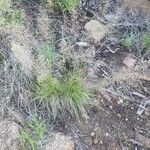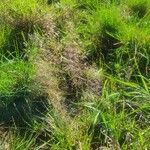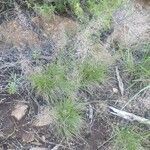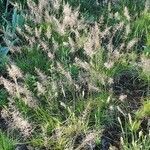Tufted perennial 100-550 mm high; old leaf sheaths splitting into fibres, no woolly hairs between the fibres. Leaf blade 20-70 x 1 to 2 mm. Inflorescence dichotomously or not dichotomously branched, axils without hairs. Spikelet 0.8-1.5 mm long; lower glume up to 1/3 as long as spikelet, apex obtuse; upper glume 1/2-2/3 as long as spikelet, apex acute or cuspidate; lemma as long as spikelet, narrowly ovate, acute; anther 0.6-0.8 mm long.
Densely caespitose perennial without rhizomes or stolons; culms up to 60(70) cm tall, erect, unbranched; basal leaf sheaths firmly chartaceous, glabrous or ciliate on the margins, terete, eventually disintegrating in to a cushion of persistent, glabrous or thinly pilose fibres; leaf laminas 2–15 cm × 1–2 mm, usually involute, sometimes flat, smooth or scaberulous on the surfaces, scabrid on the margins, acute at the apex.
Spikelets 1–1.6 mm long, greyish-green or purplish; inferior glume 1/5–1/3(2/5) the length of the spikelet, oblong to narrowly ovate, nerveless, glabrous, obtuse at the apex; superior glume 1/2–2/3 the length of the spikelet, narrowly ovate, 1-nerved, glabrous, acute or cuspidate at the apex, the nerve not excurrent; lemma as long as the spikelet, narrowly ovate, acute; anthers 3, 0.6–0.8 mm long.
A grass that keeps growing from year to year. It forms tufts. It grows 60 cm high. The leaf sheath at the base is papery. It turns into fibres. The leaf blade is 2-15 cm long by 1-2 mm wide. The edges roll inwards. The flower panicle is 3-22 cm long. It is narrowly oval. The seeds or grains are 0.5-0.7 mm long.
Perennial; up to 0.55 m high; tufted; rhizome absent. Leaf blades 20-70 x 1-2 mm; old leaf sheaths splitting into fibres; lacking woolly hairs between them. Flowers: panicle dichotomously or not dichotomously branched; without hairs in axils; spikelets 0.8-1.5 mm long; upper glume 1/2-2/3 as long as spikelet.
Perennial, tufted, up to 0.55 m high. Leaf blades 20-70 mm long, 1-2 mm wide, old leaf sheaths splitting into fibres, lacking woolly hairs between them. Spikelets 0.8-1.5 mm long. Panicle dichotomously branched without hairs in axils.
Panicle 3–22 cm long, narrowly ovate, very delicate and diffuse, the branches capillary and tinged with red; primary branches not in whorls, smooth or scaberulous, eglandular, the spikelets evenly distributed.
Densely tufted perennial up to 60 cm. high, with strongly fibrous base
Grain 0.5–0.7(0.85) mm long, elliptic to obovate, oblong in section.
Very delicate, often reddish, inflorescence




